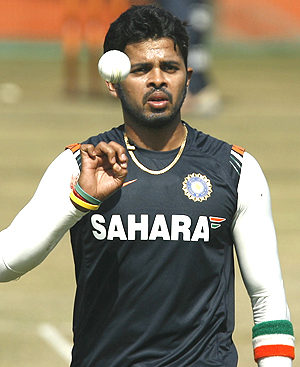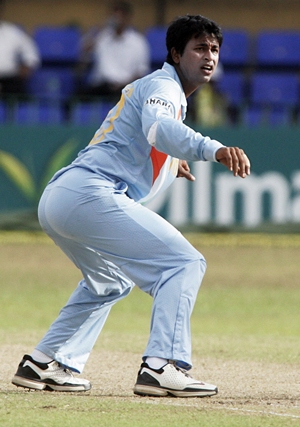
With the help of statistics, Aabhas Sharma analyses four knotty questions the selection of the Indian team for World Cup 2011 has thrown up.
Why has S Sreesanth been excluded? Who will partner Zaheer Khan in the pace attack?
To begin with, Sreesanth, with 6.01 runs per over, has been more expensive than Munaf Patel (4.74), Ashish Nehra (5.19) and Praveen Kumar (5.07) in one-day cricket.
However, on home turf, where India will play its matches, he has gone for fewer runs than Nehra (6.46 vs 6.48). His bowling average (32.04) is poorer than Patel (29.81) and Nehra (31.32), but better than Kumar (33.57).
On Indian wickets, his average is better than all three. What should have worked in Sreesanth's favour is that he is in form and less prone to injuries than Patel and Nehra. What perhaps went against him were his run-ins on and off the field.
The numbers also suggest who could be Khan's bowling partner if India goes for a two-pace attack. Patel has the best average and is also the most economical of the three.
If the team decides to play a third seamer, Nehra scores over Kumar on average but loses out on economy. What could swing the matter for Nehra is his experience of 153 matches. But his fielding is awkward and Kumar can be handy with the bat.

Why have Piyush Chawla and R Ashwin been chosen over Pragyan Ojha? Who'll be the second spinner?
This one's a googly: Ojha's average and economy rate (20.05, 4.13) are better than Chawla's (32.53, 4.96) and Ashwin's (23.21, 4.92). Yet, he has been kept out of the team. Rumour mills suggest that Chawla, the chubby spinner from Uttar Pradesh, was strongly supported by skipper Mahendra Singh Dhoni and coach Gary Kirsten.
All three lack experience Chawla leads with 21 one-day internationals. So statistics must have played a limited role in Chawla's and Ashwin's selection and Ojha's omission.
Chawla is considered a better batsman and fielder than Ojha, so that may have tipped the scales in his favour. As a leg-spinner, he could add variety to the Indian spin attack along with Harbhajan Singh's off-breaks.
Granted, the World Cup is being played on slow and turning tracks but, with at least two-part-time bowlers certain to play, the spin department remains a bit unsure. Who will be Harbhajan Singh's partner if India decides to go for two spinners? If current form is anything to go by, it could be Ashwin, who has shown a lot of promise of late.

Who is the best option for a part-time bowler? Does India have enough bowling options?
Apart from four bowlers, of whom only Khan and Harbhajan Singh are certain, India will need at least two part-time bowlers to share ten overs.
If a specialist bowler fails to find his rhythm, a third one may have to be pressed into service. This may very well decide the middle order of the team.
Yuvraj Singh, with 5.04 runs per over, is more economical than Yusuf Pathan (5.66) and Suresh Raina (5.30). But, numbers suggest, Pathan has the best arm of the three: His bowling average of 34.06 is better than Yuvraj Singh (40.15) and Raina (54.85).
Of the three, Yuvraj Singh has taken the most wickets: In 262 matches, he has bagged 89 scalps. Pathan has taken 29 in 42 matches and Raina 7 in 108. This greater match experience could weigh in Yuvraj Singh's favour.
If push comes to shove, there are other bowling options as well: Both Tendulkar and Sehwag can bowl. Tendulkar, though he hasn't turned his arm for quite some time, has taken 154 wickets in 442 matches with an average of 44.26, and Sehwag has taken 92 in 228 matches (average: 40.39).
What India lacks is a genuine all-rounder, Harbhajan Singh's recent heroics with the bat notwithstanding.

Why has Rohit Sharma not been included in the team? Who is the best bet in the middle order?
Sharma has good technique, good temperament and isn't afraid to play the big shots.
But as good a batsman as Sharma might look, his one-day record is quite poor. A batting average of 28.22 in 59 games and a strike rate of 76 are just not good enough for someone who wants to stake his claim in India's middle order. His average (32.50) and strike rate (79.26) are better at home, but then he has played only nine matches on Indian soil.
True, Pathan's average of 29.33 is not vastly superior, but his average at home (55.80) is way ahead of Sharma (32.50). Of the four middle-order batsmen in the team, Virat Kohli's average of 45.73 is better than Yuvraj Singh (36.97), Pathan (29.33) and Raina (38.30).
On home turf, both Kohli and Pathan average above 55 (see table). Pathan's strike rate (runs per 100 balls) is the highest at 110, followed by Raina (90.08), Yuvraj Singh and Kohli (81.97).
On Indian pitches, Pathan's strike rate is 134.78! Pathan can hit huge sixes, but his ability to face short-pitched fast deliveries is suspect.
That brings the spotlight on Kohli who has been in pretty good nick over the last few series and is a sharp fielder as well. Yuvraj Singh is the other certainty in the playing eleven.